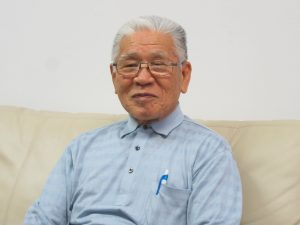First his grandmother died, and then his uncle died, just a year after the end of World War II. That’s when Masayuki Saito began thinking more deeply about life. In 1958, Masayuki moved to Brazil, leaving behind a Japan battered by post-war recession.
In Brazil, he met Setsuko, whom he married. They began regularly attending services at Higashi Honganji Betsuin temple in Sao Paolo and learning about Jodo Shinshu.
Back in Japan, Masayuki’s hometown was affiliated with the Rinzai sect of Zen Buddhism. His father served as representative of a local temple, while his cousin had become a priest. Such was his strong connection to Zen.
However, Setsuko’s parents were devout Jodo Shinshu followers and that link tied Masayuki to the Nembutsu teachings. “My wife’s family always paid close attention to Nenbutsu (reciting “Namu Amida Butsu”) and my father-in-law Katsujiro was popularly known as ‘Nenbutsu Katsujiro,’” Masayuki said. “My mother-in-law could recite sentence after sentence from ‘The Sayings of Rennyo Shonin’ in the course of a normal conversation.”
Masayuki gradually came to appreciate the teachings, drawn to the words of Shinran Shonin that emphasize how the Nembutsu dwells in the life of each person.
At the temple, he listened to a lecture by Buddhist scholar Yutai Ikeda from Japan. Professor Ikeda talked about a Japanese phrase—usually translated as “‘calling’ or ‘asking’ Amida Buddha”—explaining we should think of Amida as within us, rather than “outside” us.
“For a long time, I went to the temple thinking Amida was something like ‘God out there,’” Masayuki said. “Professor Ikeda completely overturned my thinking.”
Buddhism in Brazil is a religion springing from the history and culture of Japanese Brazilians, but should not be limited by that past, he said. While some of these “Nikkei” people may abandon Jodo Shinshu, it has something to offer everyone. “It is our task to spread these teachings all over the world,” he said.
Masayuki Saito is a member of the Sao Paolo Betsuin Temple.


